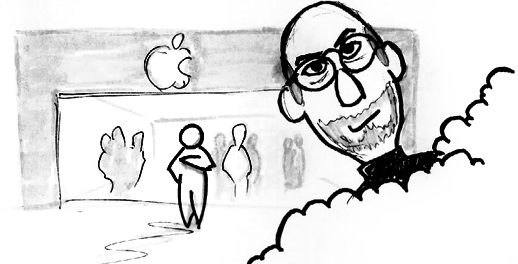
Even the best product designers put people at the heart of what they do. It's
a deadly mistake to believe in
the myth of the lone genius innovator. Anticipating people's needs and big market opportunities years out into the future requires a deep understanding of our fellow humans. This does not come from innate talent, it comes from hard work by individuals who relentlessly put others at the center of what they say, think, and do.
Just last week Louis Corso, our customer service advocate, told us a story from his days working at the Stanford Apple Store in Palo Alto, CA. It's well known that Steve Jobs would frequent this store, but Louis offered another small insight:
We would find him hiding behind the bushes or around the corner outside, peering inside to see what was going on. We would go, "There's Steve! Everybody play cool." We thought he was evaluating us. It was nerve-wracking.
Steve wasn't observing just the employees, he was taking in the entire experience from as many sides and angles as he could. He was directly observing how customers acted around his products and teasing out what they believed about his company. He was staying in touch, albeit from a slightly comic distance from Louis' description.
A key insight here is that Jobs was not born with this instinct, he meticulously cultivated it through observation of people and enlightened trial-and-error with his product teams. The New York Times picked up on
Jobs' approach recently:
Employees at Apple stores provide the company with a powerful window into user habits and needs, even if it is not conventional market research. "Steve visits the Apple store in Palo Alto frequently," said Mr. McKenna, a former consultant to Apple. The design decisions made by Mr. Jobs, Mr. McKenna said, are informed by his grasp of users' desires, technology trends and popular culture.
This same mentality is near and dear to us. We don't like heavy market research because it distances you from real people and the real interactions they have with your products. We like simple hands-on techniques that help everyone within an organization to cultivate that same rich mental model for their audience so they can imagine into the future just like Jobs.
This is one way we build culture into teams so they are capable of consistently designing things of value for people. It's simple little things like observing people on their laptops at a coffee shop, asking people on a plane what they think of their Kindle, or even just watching the various people in your office use everyday things related to your product. Do that enough and you layer in an intuition for people's expectations and beliefs.
Companies capable of doing this together have a powerful way to keep out-innovating their competition into the future.
 Even the best product designers put people at the heart of what they do. It's a deadly mistake to believe in the myth of the lone genius innovator. Anticipating people's needs and big market opportunities years out into the future requires a deep understanding of our fellow humans. This does not come from innate talent, it comes from hard work by individuals who relentlessly put others at the center of what they say, think, and do.
Just last week Louis Corso, our customer service advocate, told us a story from his days working at the Stanford Apple Store in Palo Alto, CA. It's well known that Steve Jobs would frequent this store, but Louis offered another small insight:
Even the best product designers put people at the heart of what they do. It's a deadly mistake to believe in the myth of the lone genius innovator. Anticipating people's needs and big market opportunities years out into the future requires a deep understanding of our fellow humans. This does not come from innate talent, it comes from hard work by individuals who relentlessly put others at the center of what they say, think, and do.
Just last week Louis Corso, our customer service advocate, told us a story from his days working at the Stanford Apple Store in Palo Alto, CA. It's well known that Steve Jobs would frequent this store, but Louis offered another small insight: